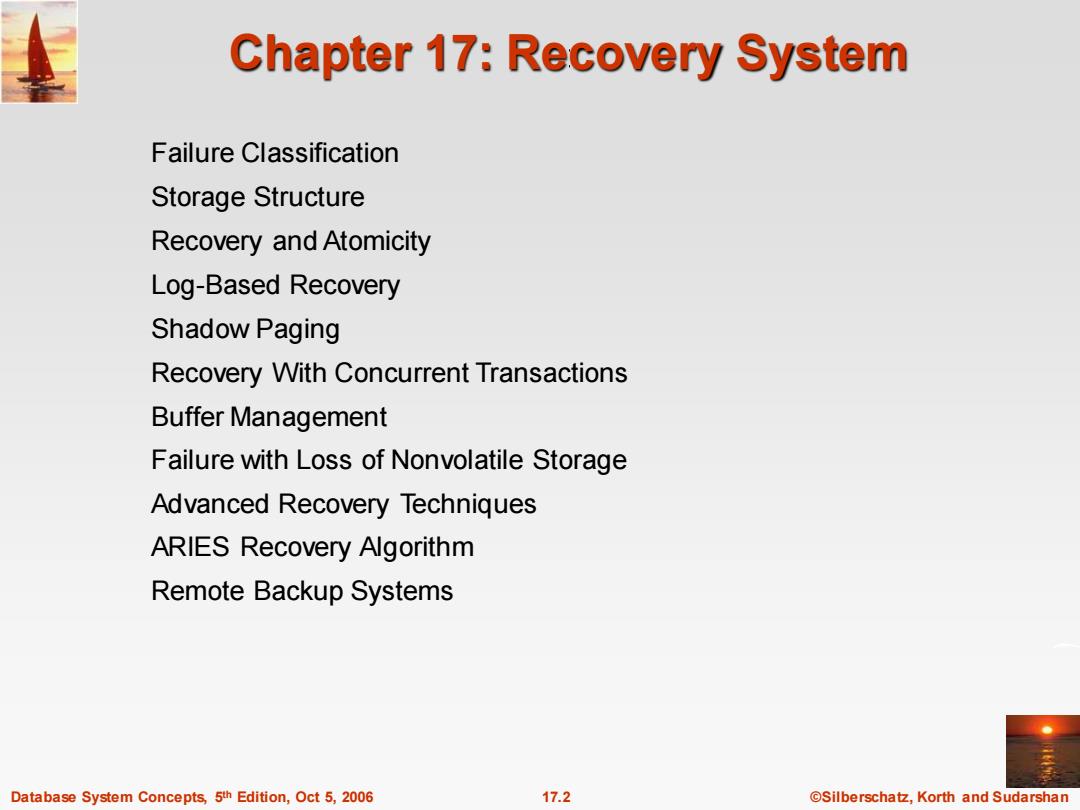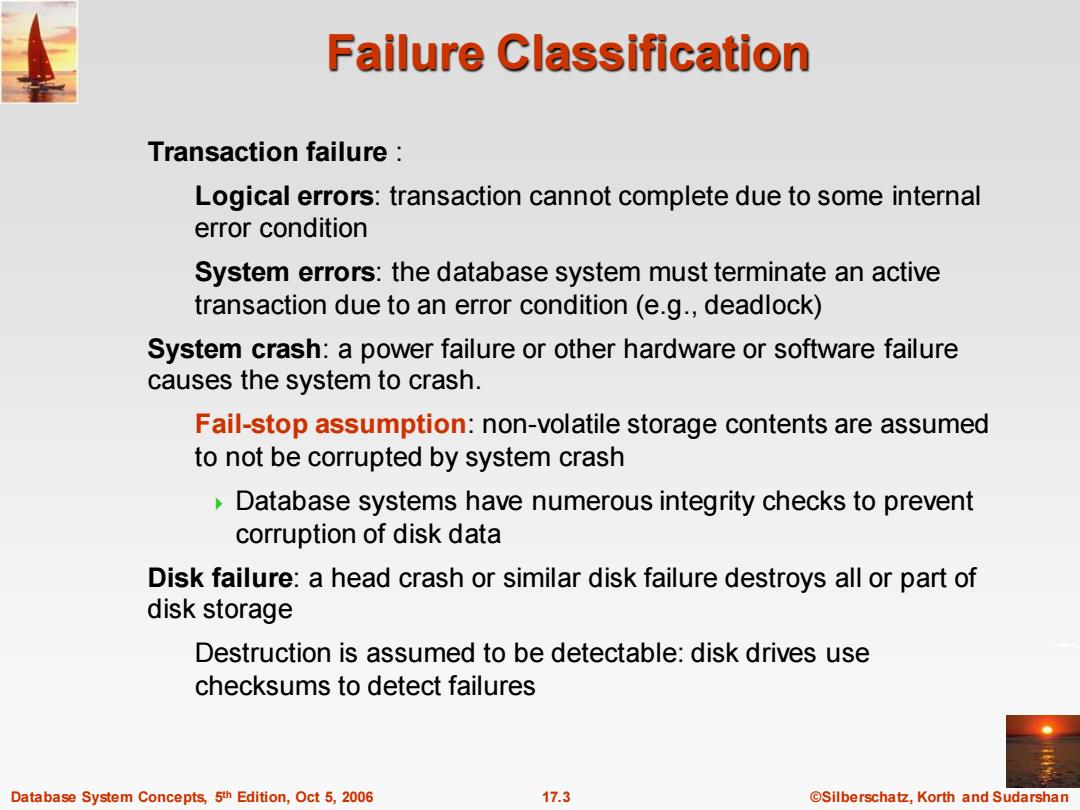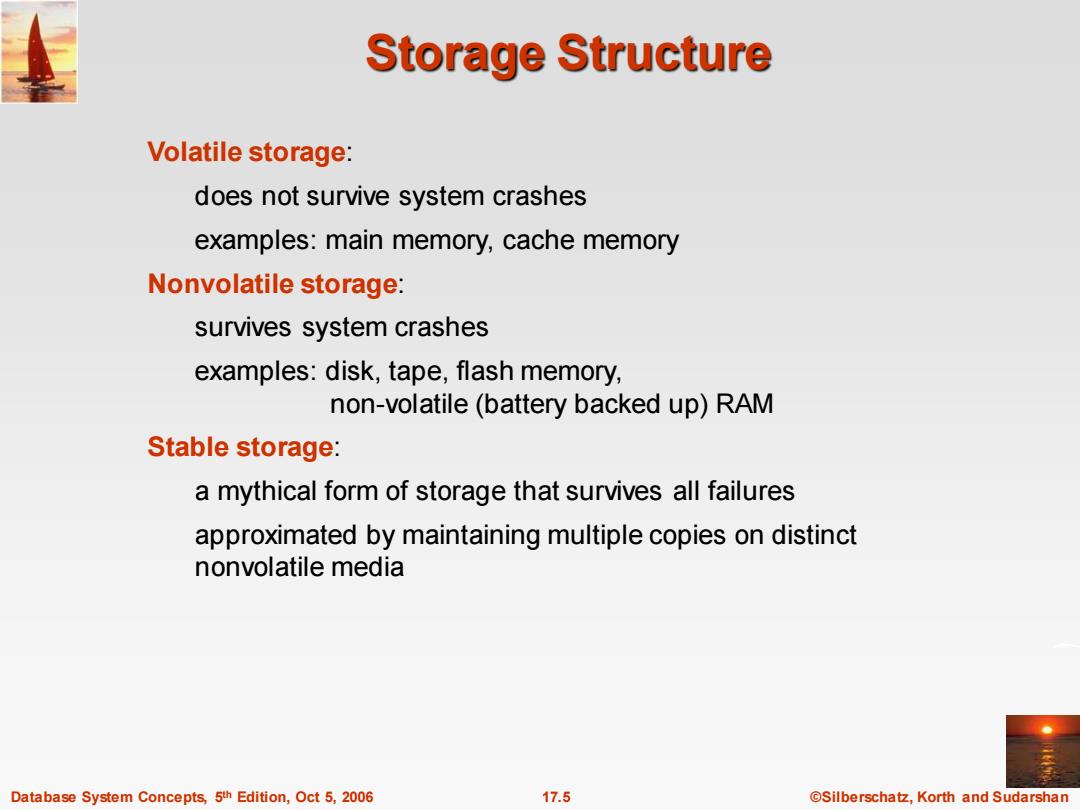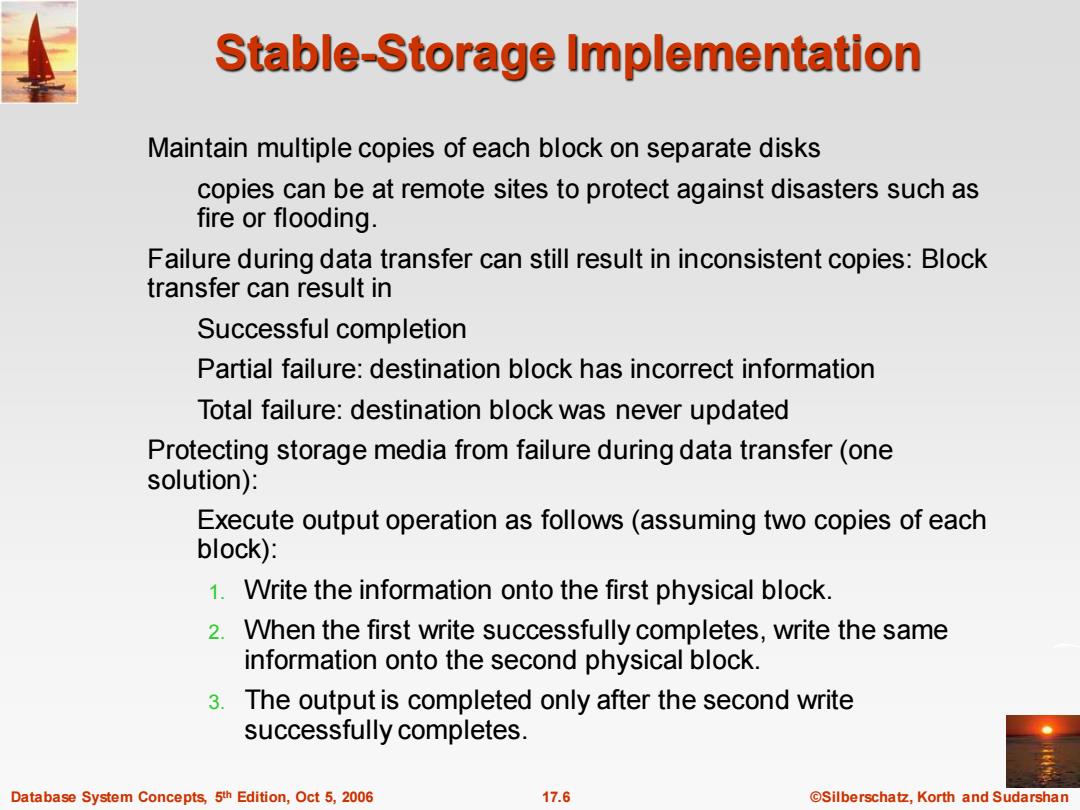
Chapter 17:Recovery System Failure Classification Storage Structure Recovery and Atomicity Log-Based Recovery Shadow Paging Recovery With Concurrent Transactions Buffer Management Failure with Loss of Nonvolatile Storage Advanced Recovery Techniques ARIES Recovery Algorithm Remote Backup Systems Database System Concepts,5th Edition,Oct 5,2006 17.2 @Silberschatz,Korth and Sudarshan
Database System Concepts, 5 17.2 ©Silberschatz, Korth and Sudarshan th Edition, Oct 5, 2006 Chapter 17: Recovery System Failure Classification Storage Structure Recovery and Atomicity Log-Based Recovery Shadow Paging Recovery With Concurrent Transactions Buffer Management Failure with Loss of Nonvolatile Storage Advanced Recovery Techniques ARIES Recovery Algorithm Remote Backup Systems

Failure Classification Transaction failure: Logical errors:transaction cannot complete due to some internal error condition System errors:the database system must terminate an active transaction due to an error condition(e.g.,deadlock) System crash:a power failure or other hardware or software failure causes the system to crash. Fail-stop assumption:non-volatile storage contents are assumed to not be corrupted by system crash Database systems have numerous integrity checks to prevent corruption of disk data Disk failure:a head crash or similar disk failure destroys all or part of disk storage Destruction is assumed to be detectable:disk drives use checksums to detect failures Database System Concepts,5th Edition,Oct 5,2006 17.3 ©Silberschat乜,Korth and Sudarshan
Database System Concepts, 5 17.3 ©Silberschatz, Korth and Sudarshan th Edition, Oct 5, 2006 Failure Classification Transaction failure : Logical errors: transaction cannot complete due to some internal error condition System errors: the database system must terminate an active transaction due to an error condition (e.g., deadlock) System crash: a power failure or other hardware or software failure causes the system to crash. Fail-stop assumption: non-volatile storage contents are assumed to not be corrupted by system crash Database systems have numerous integrity checks to prevent corruption of disk data Disk failure: a head crash or similar disk failure destroys all or part of disk storage Destruction is assumed to be detectable: disk drives use checksums to detect failures

Recovery Algorithms Recovery algorithms are techniques to ensure database consistency and transaction atomicity and durability despite failures Focus of this chapter Recovery algorithms have two parts 1.Actions taken during normal transaction processing to ensure enough information exists to recover from failures 2.Actions taken after a failure to recover the database contents to a state that ensures atomicity,consistency and durability Database System Concepts,5th Edition,Oct 5,2006 17.4 ©Silberschat乜,Korth and Sudarshan
Database System Concepts, 5 17.4 ©Silberschatz, Korth and Sudarshan th Edition, Oct 5, 2006 Recovery Algorithms Recovery algorithms are techniques to ensure database consistency and transaction atomicity and durability despite failures Focus of this chapter Recovery algorithms have two parts 1. Actions taken during normal transaction processing to ensure enough information exists to recover from failures 2. Actions taken after a failure to recover the database contents to a state that ensures atomicity, consistency and durability

Storage Structure Volatile storage: does not survive system crashes examples:main memory,cache memory Nonvolatile storage: survives system crashes examples:disk,tape,flash memory, non-volatile(battery backed up)RAM Stable storage: a mythical form of storage that survives all failures approximated by maintaining multiple copies on distinct nonvolatile media Database System Concepts,5th Edition,Oct 5,2006 17.5 @Silberschatz,Korth and Sudarshan
Database System Concepts, 5 17.5 ©Silberschatz, Korth and Sudarshan th Edition, Oct 5, 2006 Storage Structure Volatile storage: does not survive system crashes examples: main memory, cache memory Nonvolatile storage: survives system crashes examples: disk, tape, flash memory, non-volatile (battery backed up) RAM Stable storage: a mythical form of storage that survives all failures approximated by maintaining multiple copies on distinct nonvolatile media

Stable-Storage Implementation Maintain multiple copies of each block on separate disks copies can be at remote sites to protect against disasters such as fire or flooding. Failure during data transfer can still result in inconsistent copies:Block transfer can result in Successful completion Partial failure:destination block has incorrect information Total failure:destination block was never updated Protecting storage media from failure during data transfer(one solution): Execute output operation as follows(assuming two copies of each block): 1.Write the information onto the first physical block. 2.When the first write successfully completes,write the same information onto the second physical block. 3. The output is completed only after the second write successfully completes. Database System Concepts,5th Edition,Oct 5,2006 17.6 ©Silberschat乜,Korth and Sudarshan
Database System Concepts, 5 17.6 ©Silberschatz, Korth and Sudarshan th Edition, Oct 5, 2006 Stable-Storage Implementation Maintain multiple copies of each block on separate disks copies can be at remote sites to protect against disasters such as fire or flooding. Failure during data transfer can still result in inconsistent copies: Block transfer can result in Successful completion Partial failure: destination block has incorrect information Total failure: destination block was never updated Protecting storage media from failure during data transfer (one solution): Execute output operation as follows (assuming two copies of each block): 1. Write the information onto the first physical block. 2. When the first write successfully completes, write the same information onto the second physical block. 3. The output is completed only after the second write successfully completes